An Ecosystem View of Peer-to-Peer Electricity Trading: Scenario Building by Business Model Matrix to Identify New Roles †
Abstract
:1. Introduction
| Levels of Value Generation | Type of Value | References |
|---|---|---|
| End customer value | − Autarky, self-sufficiency, or independence of energy supply | [11,12,13,14,15,16,17] |
| − Autonomy | [11,15,18,19,20,21,22,23] | |
| − Green energy | [13,15,24] | |
| − Lower electricity costs | [22,23,24,25,26] | |
| − Positive attitude to regionality | [13,19,20,22,23] | |
| − Sense of community identity | [27] | |
| − Intangible returns (built upon the notion of togetherness, friendship, love, solidarity, and different ways of bonding with others) | [28,29] | |
| − Responsibility to future generation | [15] | |
| − Sustainable lifestyle | [21] | |
| − Desire for greater agency (active participation) in the energy transition | [13,21,30,31] | |
| − Social comparison | [13,15,30] | |
| − Perceived importance of shared generation and consumption and easy implementation | [20] | |
| Business value | − Make electricity less expensive, including making renewable energy more profitable and “supporting new and better mechanisms for return-on-investment beyond government subsidies” | [13,21,22,23,32] |
| Collaborative value | − Electricity grid balancing and stability | [15] |
| − Transmission losses are minimized, making local energy communities more robust against failures of the electricity grid | [7] | |
| Socio-Environmental value | − More socially equitable energy system | [30,31] |
| − Cleaner energy system | [31] | |
| − Involves sharing electricity, underlining that not only monetary but also ideological reasons motivated participation | [20,23] | |
| − Intangible returns are built upon the notion of togetherness, friendship, love, solidarity, and different ways of bonding with others | [29] | |
| − Environmental benefits | [13,20,27] |
2. Materials and Methods
2.1. Value Network Analysis
Roles, Transactions, and Deliverables
2.2. Business Model Matrix
2.3. Scenario Building
3. Results
3.1. Value Network of the Current Electricity Market
3.1.1. Roles and Activities in Current Electricity Markets
- Consumers are parties that are connected to the grid and consume electricity. If the consumers also own electricity generation units (e.g., solar panels), then they can not only withdraw but also inject electricity to the grid, and they are called prosumers. Consumers/prosumers can be two types: residential or non-residential.
- Suppliers are responsible for buying and selling electricity. They buy the electricity from the producers, with whom they have bilateral contracts, or from power exchanges. Then, they resell this electricity to their customers, i.e., consumers, who they invoice individually.
- Distribution System Operators (DSOs) manage, develop, and maintain the medium to low voltage grid, called the distribution network, for a specific territory. They provide new connections to the network and are responsible for reading consumers’ electricity meters. They receive electricity from the transmission networks, local production sites, or neighboring DSOs and distribute it to small businesses and residential houses [1].
- Transmission System Operator (TSO) transfers electricity at high voltages, via transmission lines from generators and across borders to the distribution network. The TSO develops, builds, and maintains the transmission grid according to long term needs. It monitors the electricity system in real time. It offers market players opportunities to optimize their electricity management by selling their surplus electricity or temporarily reducing consumption. They can request balancing or ancillary services from consumers and generators alike, through flexibility and available capacity, respectively [1].
- Producers are the generators of electricity, ranging from large nuclear, gas, or coal power plants, to smaller distributed generators such as residential solar panels. They are usually rated by their generating capacity and their operational flexibility [55].
- Aggregators are the parties that support the TSO in balancing the grid by managing the available flexibility (assets) of large consumers in return for monetary rewards.
- Regulators monitor and regulate the liberalized electricity markets, ensuring their efficient and reliable operation as well as compliance with environmental and social public service obligations.
3.1.2. Status Quo Value Network of the Electricity Market
3.2. Analyzing the Electricity Market to Find Sources of Uncertainty
- Combination of assets: There are two extreme conditions imaginable for combination of assets in a network of firms. The combination of assets is categorized as distributed if important resources are in control of several actors. On the opposite extreme, if they are concentrated in the hands of a limited number of actors and the rest only possess generic resources, asset combination is concentrated. The majority of electricity is still centrally generated in power plants. Thanks to the widespread use of RES and an increasing number of batteries, the electricity market is experiencing a transition from concentrated to distributed combination of assets. The overall number and the share of distributed electricity generation are both increasing, which indicates the transition from a concentrated combination of assets to distributed settings.
- Vertical integration: Markets are considered vertically integrated if most of the value is generated and captured by a limited number of actors. Liberalization attempts to break such vertical integrations. The electricity market has experienced several steps towards liberalization, and some tasks have been delegated by governments to competitive enterprises, but still, there are critical roles in the hands of monopoly actors (e.g., governments, etc.) [56]. Figure 4 shows the current value network of the electricity market, highlighting the actors and their activities. Peer-to-peer electricity trading enforces in favor of more liberalization in the electricity market. Furthermore, it introduces new roles in electricity markets (see Section 4).
- Customer ownership: This explains which actor in a value network has direct contacts with customers and has direct access to their information. In the case of the electricity market, this parameter represents the access to consumers/prosumers’ information (including their consumption and production patterns).
- The main two options for customer ownership are direct and indirect choices. In the former, a producer is in direct contact with customers, whereas in the latter there is one or more intermediaries between producers and customers [57]. In the current electricity market, retailers are in direct contact with consumers. Knowing that retailers are not commonly the producer of the electricity and considering scale constraints, which limit the possibility of direct customer ownership, they play the intermediary role between generators and customers. Thus, the customer ownership situation in the current electricity market is intermediated. Smart local energy systems with numerous prosumers equipped with RES (who are not tied to a minimum capacity to be efficient), storage devices, and smart IoT devices with the possibility to trade electricity in peer-to-peer settings make it possible to have direct customer ownership as well in the future. The high value of customer information imposes privacy and security considerations, which make prediction about the future of customer ownership in the electricity market uncertain. Thus, customer ownership is considered as one of the main sources of uncertainty for the future [58].
- Modularity: From a technical perspective, a system is modular if distinct modules can connect to each other via predetermined interfaces. In a modular system, changing a module does not affect others. If the independence of artifacts is not the case in a system, it is considered integrated. Considering the constraints imposed by the grid infrastructure, modularity is the case before smart meters and integrity is the case after smart meters.
- Distribution of intelligence: This represents how the processing power is spread and how a system is being controlled/managed to deliver a specific product/service. A shift is expected from a centralized network topology towards a more decentralized one in the future peer-to-peer trading market (e.g., by applying Distributed Ledger Technologies [59,60]).
- Interoperability: This refers to the possibility of direct exchange of information between different technological systems and to the compatibility of products/services coming from different sources. Interoperable and stand-alone architectures are the main two options for this element. There is a common platform (electricity grid) in place, which every system in the electricity grid tends to be compatible with. It justifies considering the system to be interoperable.
- Cost (sharing) model: The question is whether investments are made by one (or by a limited number of) actors, or if they distributed over various actors. Most of the required investments in the electricity market (large-scale generation investments, grid infrastructure, maintenance, smart meters, etc.) are still made by a limited number of actors (TSO, DSO, or other monopoly actors). By investing in RES, batteries, HEMS, etc., other actors are getting involved and the cost (sharing) model is going to be more distributed.
- Revenue model: This is a very contextual element in the business model matrix framework. A traditional trade-off in this regard is between direct and indirect revenue models. In the former model, consumers are the payers for the service which they receive, while in the latter, third parties (e.g., advertisers, subsidies, etc.) are the payers. There is still no observable motivation for third parties to pay on behalf of consumers in pursuit of a profit. Thus, the revenue model in the electricity market can be classified as direct. Indirect revenue models are expected to be justified by utilizing trading platforms.
- Revenue sharing model: This refers to arrangements on whether and how actors in a value network share revenues with each other. The two main options are having a revenue sharing model in place or not. While in the former option revenues are spread amongst several actors, in the latter revenues are concentrated with a single actor and other actors are involved through direct market mechanisms, licenses, etc. Revenues are concentrated with a limited number of actors, and a set of agreements among actors are in place which clarify how revenues are being shared between actors in the current electricity market. The emergence of the peer-to-peer markets will increase the number of involved actors in revenue sharing. Thus, the revenue sharing model in the electricity market is classified as having a revenue sharing model in place.
- Positioning: The trade-off is to position a product/service as a complement to a particular set of existing ones, or a substitute for them. Distributed generated electricity (which is the case for trading in the peer-to-peer market) seems to play the role of complement for the centrally generated electricity. Moreover, there are still other important services that consumers are receiving by being connected to the electricity grid (e.g., flexibility services).
- User involvement: It is a defining success factor of business models, especially for the case of products/services with information ingredients. Active users can be a source of new services. Passive users’ behaviors can open up opportunities for new actors in a market to represent them. The main trade-off regarding user involvement in business modelling is to classify it as high or low. It is high when customers are actively involved and low when they are passive towards value creation and capture through their involvement. Users’ involvement in the electricity market is going to increase as a result of the emergence of peer-to-peer trading. Nevertheless, how active citizens decide to be in future peer-to-peer markets is influenced by several factors (expected monetary returns, etc.). Level of citizen activeness (or passiveness) builds different scenarios for the future. Thus, user involvement is considered as one of the main sources of uncertainty about the future [58].
- Intended value: Actors in a market adjust their strategies to maximize customer value as one of their objectives. Strategies can be simplified in their roots to price/quality versus custom-made solutions. Price and quality (e.g., stability of service in the electricity market) of the services are more valued by customers in general rather than custom-made solutions in the electricity market.
3.2.1. Building Future Scenarios for Peer-to-Peer Electricity Trading
- (S1)
- Direct peers: Active citizens and direct customer ownership.
- (S2)
- Direct customers: Passive citizens with direct customer ownership. In other words, representatives trade on behalf of their clients.
- (S3)
- Indirect customers: Passive citizens with intermediate customer ownership. Trade is facilitated by an intermediary party (i.e., broker) who accesses the involved parties’ information.
- (S4)
- Indirect peers: Active citizens with intermediated customer ownership.
3.2.2. Value Network of the Future Electricity Market: Incorporating the Peer-to-Peer Electricity Trading
- Broker is an intermediate actor who facilitates (i.e., supports prosumers to perform) trading in the peer-to-peer electricity markets. It has access to information of all involved parties in the peer-to-peer trading and their transactions. It is reasonable to assume that brokers share this information with the DSOs and the TSO, contributing towards balancing the grid. There are several candidates to undertake this role; amongst the current players, suppliers can be mentioned.
- Representatives represent their clients (prosumers) in electricity markets (including the peer-to-peer electricity markets). To do so, they manage their clients’ assets (i.e., battery, solar panels, flexibility) and information. In other words, they transform passive citizens to active players in the market. Amongst the current market players, aggregators and suppliers seem to have the required expertise for this role.
4. Discussion
4.1. Impact on the Electrical Grid
4.2. Security and Privacy
4.3. Legal Perspective on Emerging Roles
4.3.1. Data Protection Application
4.3.2. Roles Provided by Data Protection Law
- Data controller: the one who “alone or jointly with others determine[s] the purposes and means of the processing of personal data” (Article 4.7 GDPR). A controller’s decision establishes why and how data shall be processed.
- Data processor: someone who processes personal data on behalf of a controller (Article 4.8 GDPR). The activities entrusted to a processor may be limited to a very specific task or context or may be quite general and comprehensive. Data controller and data processor relations must be embodied by a contract or other legal act (Article 28.3 GDPR).
5. Conclusions
Author Contributions
Funding
Institutional Review Board Statement
Informed Consent Statement
Data Availability Statement
Acknowledgments
Conflicts of Interest
References
- Faia, R.; Soares, J.; Pinto, T.; Lezama, F.; Vale, Z.; Corchado, J.M. Optimal Model for Local Energy Community Scheduling Considering Peer to Peer Electricity Transactions. IEEE Access 2021, 9, 12420–12430. [Google Scholar] [CrossRef]
- Kitchin, R.; Cardullo, P.; Di Feliciantonio, C. Citizenship, Justice, and the Right to the Smart City. In The Right to the Smart City; Emerald Publishing Limited: Bingley, UK, 2019; pp. 1–24. [Google Scholar]
- Van der Graaf, S. In waze we trust: Algorithmic governance of the public sphere. Media Commun. 2018, 6, 153–162. [Google Scholar] [CrossRef] [Green Version]
- Van Der Graaf, S. The Right to the City in the Platform Age: Child-Friendly City and Smart City Premises in Contention. Information 2020, 11, 285. [Google Scholar] [CrossRef]
- Zhang, C.; Wu, J.; Long, C.; Cheng, M. Review of Existing Peer-to-Peer Energy Trading Projects. Energy Procedia 2017, 105, 2563–2568. [Google Scholar] [CrossRef]
- Montakhabi, M.; van der Graaf, S.; Ballon, P.; Walravens, N.; Vanhaverbeke, W. Defining the Business Ecosystem of Peer-to-Peer Electricity Trading. Presented at the NBM 2021, 2021; Available online: https://researchportal.vub.be/en/publications/defining-the-business-ecosystem-of-peer-to-peer-electricity-tradi (accessed on 24 May 2021).
- Murkin, J.; Chitchyan, R.; Byrne, A. Enabling peer-to-peer electricity trading. In Proceedings of theICT for Sustainability 2016, Amsterdam, The Netherlands, 29 August–1 September 2016; Atlantis Press: Amsterdam, The Netherlands, 2016; pp. 234–235. [Google Scholar]
- Morstyn, T.; Farrell, N.; Darby, S.J.; McCulloch, M.D. Using peer-to-peer energy-trading platforms to incentivize prosumers to form federated power plants. Nat. Energy 2018, 3, 94–101. [Google Scholar] [CrossRef]
- Voets, A. Blockchain Technology in the Energy Ecosystem: An Explorative Study on the Disruptive Power of Blockchain Technology in the Dutch Energy Ecosystem. 2017. Available online: https://repository.tudelft.nl/islandora/object/uuid%3Ace37e094-cf9e-4976-afde-2e0ecdf8880a (accessed on 19 May 2021).
- Montakhabi, M.; Zobiri, F.; Van Der Graaf, S.; Deconinck, G.; Orlando, D.; Vanhove, S.; Callaerts, R.; Ballon, P.; Mustafa, M.A. New Roles in Peer-to-Peer Electricity Markets: Value Network Analysis. In Proceedings of the 2020 6th IEEE International Energy Conference (ENERGYCon), Gammarth, Tunisia, 28 September–1 October 2020; Institute of Electrical and Electronics Engineers (IEEE): Piscataway, NJ, USA, 2020; pp. 389–394. [Google Scholar]
- Ecker, F.; Spada, H.; Hahnel, U.J.J. Independence without control: Autarky outperforms autonomy benefits in the adoption of private energy storage systems. Energy Policy 2018, 122, 214–228. [Google Scholar] [CrossRef]
- Fell, M.; Schneiders, A.; Shipworth, D. Consumer Demand for Blockchain-Enabled Peer-to-Peer Electricity Trading in the United Kingdom: An Online Survey Experiment. Energies 2019, 12, 3913. [Google Scholar] [CrossRef] [Green Version]
- Ableitner, L.; Tiefenbeck, V.; Meeuw, A.; Wörner, A.; Fleisch, E.; Wortmann, F. User behavior in a real-world peer-to-peer electricity market. Appl. Energy 2020, 270, 115061. [Google Scholar] [CrossRef]
- Spasova, B.; Kawamoto, D.; Takefuji, Y. Evaluation of the effects of bidding strategy with cus-tomized pricing on the individual Prosumer in a local energy market. Adv. Sci. Technol. Eng. Syst. J. 2019, 44, 366–379. [Google Scholar] [CrossRef]
- Smale, R.; Kloppenburg, S. Platforms in Power: Householder Perspectives on the Social, Environmental and Economic Challenges of Energy Platforms. Sustainability 2020, 12, 692. [Google Scholar] [CrossRef] [Green Version]
- Wörner, A.; Meeuw, A.; Ableitner, L.; Wortmann, F.; Schopfer, S.; Tiefenbeck, V. Trading solar energy within the neighborhood: Field implementation of a blockchain-based electricity market. Energy Inform. 2019, 2, 11. [Google Scholar] [CrossRef] [Green Version]
- Hahnel, U.J.; Herberz, M.; Pena-Bello, A.; Parra, D.; Brosch, T. Becoming prosumer: Revealing trading preferences and decision-making strategies in peer-to-peer energy communities. Energy Policy 2020, 137, 111098. [Google Scholar] [CrossRef]
- Ableitner, L.; Meeuw, A.; Schopfer, S.; Tiefenbeck, V.; Wortmann, F.; Wörner, A. Quartierstrom—Implementation of a Real World Prosumer Centric Local Energy Market in Walenstadt, Switzerland. arXiv 2019, arXiv:1905.07242. Available online: http://arxiv.org/abs/1905.07242 (accessed on 24 May 2021).
- Wörner, A.; Ableitner, L.; Meeuw, A.; Wortmann, F.; Tiefenbeck, V. Peer-to-Peer Energy Trading in the Real World: Market Design and Evaluation of the User Value Proposition. 2020. Available online: https://www.scopus.com/inward/record.uri?eid=2-s2.0-85084711668&partnerID=40&md5=d3c7a59f6562e63bc08dbee09eef5f20 (accessed on 1 June 2021).
- Hackbarth, A.; Löbbe, S. Attitudes, preferences, and intentions of German households concerning participation in peer-to-peer electricity trading. Energy Policy 2020, 138, 111238. [Google Scholar] [CrossRef] [Green Version]
- Wilkins, D.J.; Chitchyan, R.; Levine, M. Peer-to-Peer Energy Markets: Understanding the Values of Collective and Community Trading. In Proceedings of the 2020 CHI Conference on Human Factors in Computing Systems, Honolulu, Hawaii, USA, 25–30 April 2020; ACM: New York, NY, USA, 2020; pp. 1–14. [Google Scholar]
- Mengelkamp, E.; Schönland, T.; Huber, J.; Weinhardt, C. The value of local electricity—A choice experiment among German residential customers. Energy Policy 2019, 130, 294–303. [Google Scholar] [CrossRef]
- Löbbe, S.; Hackbarth, A.; Stillahn, T.; Pfeiffer, L.; Rohbogner, G. Customer Participation in P2P Trading: A German Energy Community Case Study; Elsevier BV: Amsterdam, The Netherlands, 2020; pp. 83–104. [Google Scholar]
- Kubli, M.; Loock, M.; Wüstenhagen, R. The flexible prosumer: Measuring the willingness to co-create distributed flexibility. Energy Policy 2018, 114, 540–548. [Google Scholar] [CrossRef]
- Plewnia, F.; Guenther, E. The Transition Value of Business Models for a Sustainable Energy System: The Case of Virtual Peer-to-Peer Energy Communities. Organ. Environ. 2020. [Google Scholar] [CrossRef]
- Lüth, A.; Weibezahn, J.; Zepter, J.M. On Distributional Effects in Local Electricity Market Designs—Evidence from a German Case Study. Energies 2020, 13, 1993. [Google Scholar] [CrossRef] [Green Version]
- Mengelkamp, E.; Staudt, P.; Garttner, J.; Weinhardt, C.; Huber, J. Quantifying Factors for Participation in Local Electricity Markets. In Proceedings of the 2018 15th International Conference on the European Energy Market (EEM), Lodz, Poland, 27–29 June 2018; Institute of Electrical and Electronics Engineers (IEEE): Piscataway, NJ, USA, 2018; pp. 1–5. [Google Scholar]
- Singh, A.; Strating, A.T.; Herrera, N.R.; van Dijk, H.W.; Keyson, D.V. Towards an ethnography of electrification in rural India: Social relations and values in household energy exchanges. Energy Res. Soc. Sci. 2017, 30, 103–115. [Google Scholar] [CrossRef]
- Singh, A.; Strating, A.T.; Herrera, N.R.; Mahato, D.; Keyson, D.V.; van Dijk, H.W. Exploring peer-to-peer returns in off-grid renewable energy systems in rural India: An anthropological perspective on local energy sharing and trading. Energy Res. Soc. Sci. 2018, 46, 194–213. [Google Scholar] [CrossRef]
- Scuri, S.; Tasheva, G.; Barros, L.; Nunes, N.J. An HCI Perspective on Distributed Ledger Technologies for Peer-to-Peer Energy Trading. In Transactions on Petri Nets and Other Models of Concurrency XV; Springer Science and Business Media LLC: Berlin/Heidelberg, Germany, 2019; pp. 91–111. [Google Scholar]
- Wilkinson, S.; Hojckova, K.; Eon, C.; Morrison, G.M.; Sandén, B. Is peer-to-peer electricity trading empowering users? Evidence on motivations and roles in a prosumer business model trial in Australia. Energy Res. Soc. Sci. 2020, 66, 101500. [Google Scholar] [CrossRef]
- Kirchhoff, H.; Strunz, K. Key drivers for successful development of peer-to-peer microgrids for swarm electrification. Appl. Energy 2019, 244, 46–62. [Google Scholar] [CrossRef]
- Murkin, J.; Chitchyan, R.; Byrne, A. Enabling peer-to-peer electricity trading. Proceedings of ICT for Sustainability 2016. Adv. Comput. Sci. Res. 2016, 234–235. [Google Scholar] [CrossRef] [Green Version]
- Montakhabi, M.; van der Graaf, S.; Madhusudan, A.; Sarenche, R.; Mustafa, M.A. Fostering Energy Transition in Smart Cities: DLTs for Peer-to-Peer Electricity Trading. In Proceedings of the 3rd IEEE International Workshop on Smart Circular Economy: In Conjunction with the 17th IEEE International Conference on Distributed Computing in Sensor Systems IEEE DCOSS, 14–16 July 2021. Virtually. [Google Scholar]
- Abidin, A.; Callaerts, R.; Deconinck, G.; Van Der Graaf, S.; Madhusudan, A.; Montakhabi, M.; Mustafa, M.A.; Nikova, S.; Orlando, D.; Schroers, J.; et al. Poster: SNIPPET—Secure and Privacy-Friendly Peer-to-Peer Electricity Trading. In Proceedings of the Network and Distributed System Security Symposium (NDSS 2020), San Diego, CA, USA, 23–26 February 2020; p. 3. [Google Scholar]
- Ballon, P. Business modelling revisited: The configuration of control and value. Info 2007, 9, 6–19. [Google Scholar] [CrossRef] [Green Version]
- Allee, V. Reconfiguring the value network. J. Bus. Strat. 2000, 21, 36–39. [Google Scholar] [CrossRef] [Green Version]
- Porter, M.E.; Strategy, C. Techniques for Analyzing Industries and Competitors; Competitive Strategy: New York, NY, USA, 1980. [Google Scholar]
- Normann, R.; Ramirez, R. From value chain to value constellation: Designing interactive strategy. Harv. Bus. Rev. 1993, 71, 65–77. [Google Scholar]
- Stabell, C.B.; Fjeldstad, Ø.D. Configuring value for competitive advantage: On chains, shops, and networks. Strateg. Manag. J. 1998, 19, 413–437. [Google Scholar] [CrossRef]
- Hawkins, R. “The ‘Business Model’ as a Research Problem in Electronic Commerce,” STAR (Socio-Economic Trends Assessment for the Digital Revolution) IST Project. Issue Report; Italy. 2001, Volume 4. Available online: https://lup.lub.lu.se/luur/download?func=downloadFile&recordOId=1337304&fileOId=1646712 (accessed on 8 June 2021).
- Chesbrough, H.W. Why companies should have open business models. MIT Sloan Manag. Rev. 2007, 48, 22. [Google Scholar]
- Zott, C.; Amit, R.; Massa, L. The Business Model: Recent Developments and Future Research. J. Manag. 2011, 37, 1019–1042. [Google Scholar] [CrossRef] [Green Version]
- Montakhabi, M.; van der Graaf, S. Open Business Models’ Actionability in Europe; EU Competi-tion Policy Analysis. J. Bus. Models 2021, 9, 1. [Google Scholar] [CrossRef]
- Sousa, T.; Soares, T.; Pinson, P.; Moret, F.; Baroche, T.; Sorin, E. Peer-to-peer and communi-ty-based markets: A comprehensive review. Renew. Sustain. Energy Rev. 2019, 104, 367–378. [Google Scholar] [CrossRef] [Green Version]
- Ballon, P.; Kern, S.; Poel, M.; Tee, R.; de Munck, S.G.E. Best Practices in Business Modelling for ICT Services. In TNO-ICT Rep. nr. 3356; Vrije Universiteit Brussel: Brussels, Belgium, 2005. [Google Scholar]
- Linder, J. Changing business models: Surveying the landscape. Accent. Inst. Strateg. Chang. 2000, 15, 142–149. [Google Scholar]
- Walravens, N.; Ballon, P. Platform business models for smart cities: From control and value to governance and public value. IEEE Commun. Mag. 2013, 51, 72–79. [Google Scholar] [CrossRef]
- Van Audenhove, L.; Delaere, S.; Ballon, P. Newspapers on Electronic Paper Devices: A Scenario Analysis of Possible Business Models. J. Media Bus. Stud. 2008, 5, 47–69. [Google Scholar] [CrossRef]
- Walravens, N.; Van Compernolle, M.; Colpaert, P.; Ballon, P.; Mechant, P.; Mannens, E. “Open Government Data”—Based Business Models—A Market Consultation on the Relationship with Government in the Case of Mobility and Route-Planning Applications. In Proceedings of the 10th International Conference on Security and Cryptography, Lisbon, Portugal, 26–28 July 2016; SCITEPRESS—Science and Technology Publications: Lisbon, Portugal, 2016; Volume 2, pp. 64–71. [Google Scholar]
- Ballon, P. Control and Value in Mobile Communications: A Political Economy of the Reconfiguration of Business Models in The European Mobile Industry. Available at SSRN 1331439. 2009. Available online: https://papers.ssrn.com/sol3/papers.cfm?abstract_id=1331439 (accessed on 8 June 2021).
- Robinson, J.A.; De Jouvenel, B.; Lary, N. The Art of Conjecture. Am. Politics Sci. Rev. 1968, 62, 236. [Google Scholar] [CrossRef]
- Ratcliffe, J. Scenario building: A suitable method for strategic property planning? Prop. Manag. 2000, 18, 127–144. [Google Scholar] [CrossRef] [Green Version]
- Drucker, P.F. Managing in a Time of Great Change; Dutton: New York, NY, USA, 1995. [Google Scholar]
- Erbach, G. Understanding Electricity Markets in the EU; European Parliamentary Research Service: Brussels, Belgium, 2016. [Google Scholar]
- Erdogdu, E. The Political Economy of Electricity Market Liberalization: A Cross-country Approach. Energy J. 2014, 35. [Google Scholar] [CrossRef] [Green Version]
- Walravens, N. Qualitative indicators for smart city business models: The case of mobile services and applications. Telecommun. Policy 2015, 39, 218–240. [Google Scholar] [CrossRef]
- Montakhabi, M.; Madhusudan, A.; van der Graaf, S.; Abidin, A.; Ballon, P.; Mustafa, M.A. Sharing Economy in Future Peer-to-peer Electricity Trading Markets: Security and Privacy Analysis. In Proceedings of the Workshop on Decentralized IoT Systems and Security (DISS), San Diego, CA, USA, 23 February 2020; pp. 1–6. [Google Scholar]
- Montakhabi, M.; van der Graaf, S.; Madhusudan, A.; Sarenche, R.; Mustafa, M.A. Distributed Ledger Technologies to Foster EnergyTransition in Smart Cities: The Case of Peer-to-PeerElectricity Trading. Presented at the 3rd IEEE International Workshop on Smart Circular Economy: In Conjunction with the 17th IEEE International Conference on Distributed Computing in Sensor Systems IEEE DCOSS, May 2021; Available online: https://researchportal.vub.be/en/publications/distributed-ledger-technologies-to-foster-energytransition-in-sma (accessed on 7 June 2021).
- Montakhabi, M.; van der Graaf, S.; Madhusudan, A.; Mustafa, M.A. Distributed Ledger Technologies to Foster Energy Transition in Smart Cities: Peer-to-Peer Electricity Trading Case. Available online: https://researchportal.vub.be/en/publications/distributed-ledger-technologies-to-foster-energy-transition-in-sm (accessed on 7 June 2021).
- Tushar, W.; Saha, T.K.; Yuen, C.; Smith, D.; Poor, H.V. Peer-to-peer trading in electricity net-works: An overview. IEEE Trans. Smart Grid 2020, 11, 3185–3200. [Google Scholar] [CrossRef] [Green Version]
- Saad, A.; Youssef, T.; Elsayed, A.T.; Amin, A.; Abdalla, O.H.; Mohammed, O. Data-centric hier-archical distributed model predictive control for smart grid energy management. IEEE Trans. Ind. Inform. 2018, 15, 4086–4098. [Google Scholar] [CrossRef]
- Deconinck, G.; Thoelen, K. Lessons from 10 Years of Demand Response Research: Smart Energy for Customers? IEEE Syst. Man Cybern. Mag. 2019, 5, 21–30. [Google Scholar] [CrossRef]
- Mustafa, M.A.; Cleemput, S.; Abidin, A. A local electricity trading market: Security analysis. In Proceedings of the 2016 IEEE PES Innovative Smart Grid Technologies Conference Europe (ISGT-Europe), Ljubljana, Slovenia, 9–12 October 2016; Institute of Electrical and Electronics Engineers (IEEE): Piscataway, NJ, USA, 2016; pp. 1–6. [Google Scholar]
- Abidin, A.; Aly, A.; Cleemput, S.; Mustafa, M.A. Secure and privacy-friendly local electricity trading and billing in smart grid. arXiv 2018, arXiv:1801.08354. [Google Scholar]
- Abidin, A.; Aly, A.; Cleemput, S.; Mustafa, M.A. An MPC-Based Privacy-Preserving Protocol for a Local Electricity Trading Market. In Proceedings of the Transactions on Petri Nets and Other Models of Concurrency XV; Springer Science and Business Media LLC: Berlin/Heidelberg, Germany, 2016; pp. 615–625. [Google Scholar]
- Mustafa, M.A.; Cleemput, S.; Aly, A.; Abidin, A. A Secure and Privacy-Preserving Protocol for Smart Metering Operational Data Collection. IEEE Trans. Smart Grid 2019, 10, 6481–6490. [Google Scholar] [CrossRef] [Green Version]
- Mustafa, M.A.; Zhang, N.; Kalogridis, G.; Fan, Z. DEP2SA: A Decentralized Efficient Privacy-Preserving and Selective Aggregation Scheme in Advanced Metering Infrastructure. IEEE Access 2015, 3, 2828–2846. [Google Scholar] [CrossRef]
- Abrishambaf, O.; Lezama, F.; Faria, P.; Vale, Z. Towards transactive energy systems: An analysis on current trends. Energy Strat. Rev. 2019, 26, 100418. [Google Scholar] [CrossRef]
- Lee, A.; Brewer, T. Guidelines for Smart Grid Cyber Security: Volume 1, Smart Grid Cyber Security Strategy, Architecture, and High-level Requirements; NISTIR 7628; National Institute of Standards and Technology Interagency: Gaithersburg, MD, USA, 2010.
- Force, S.G.T. 14 Expert Group 2: Regulatory Recommendations for Privacy, Data Protection and Cyber-Security in the Smart Grid Environment, Data Protection Impact Assessment Template for Smart Grid and Smart Metering Systems; European Commission: Brussels, Belgium, 2016. [Google Scholar]
- Magdziarczyk, M. Right to be forgotten in light of regulation (eu) 2016/679 of the european parliament and of the council of 27 april 2016 on the protection of natural persons with regard to the processing of personal data and on the free movement of such data, and repealing directive 95/46/ec. In 6th SGEM International Multidisciplinary Scientific Conferences on Social Sciences and ARTS Proceedings, Modern Science; Stef92 Technology: Sofia, Bulgaria, 2019; pp. 177–184. [Google Scholar]
- Party, D.P.W. Opinion 05/2014 on Anonymisation Techniques. Diunduh Dari. 2014. Available online: https://www.pdpjournals.com/docs/88 (accessed on 7 June 2021).
- Buttarelli, G. Opinion of the European Data Protection Supervisor on the Commission Recommendation on Preparations for the Roll-Out of Smart Metering Systems; EU Recommendation: Brussels, Belgium, 2012. [Google Scholar]
- Harvey, S.J. Smart meters, smarter regulation: Balancing privacy and innovation in the electric grid. UCLA Law Rev. 2013, 61, 2068. [Google Scholar]
- Knyrim, R.; Trieb, G. Smart metering under EU data protection law. Int. Data Priv. Law 2011, 1, 121–128. [Google Scholar] [CrossRef]
- King, N.J.; Jessen, P.W. Smart metering systems and data sharing: Why getting a smart meter should also mean getting strong information privacy controls to manage data sharing. Int. J. Law Inf. Technol. 2014, 22, 215–253. [Google Scholar] [CrossRef]
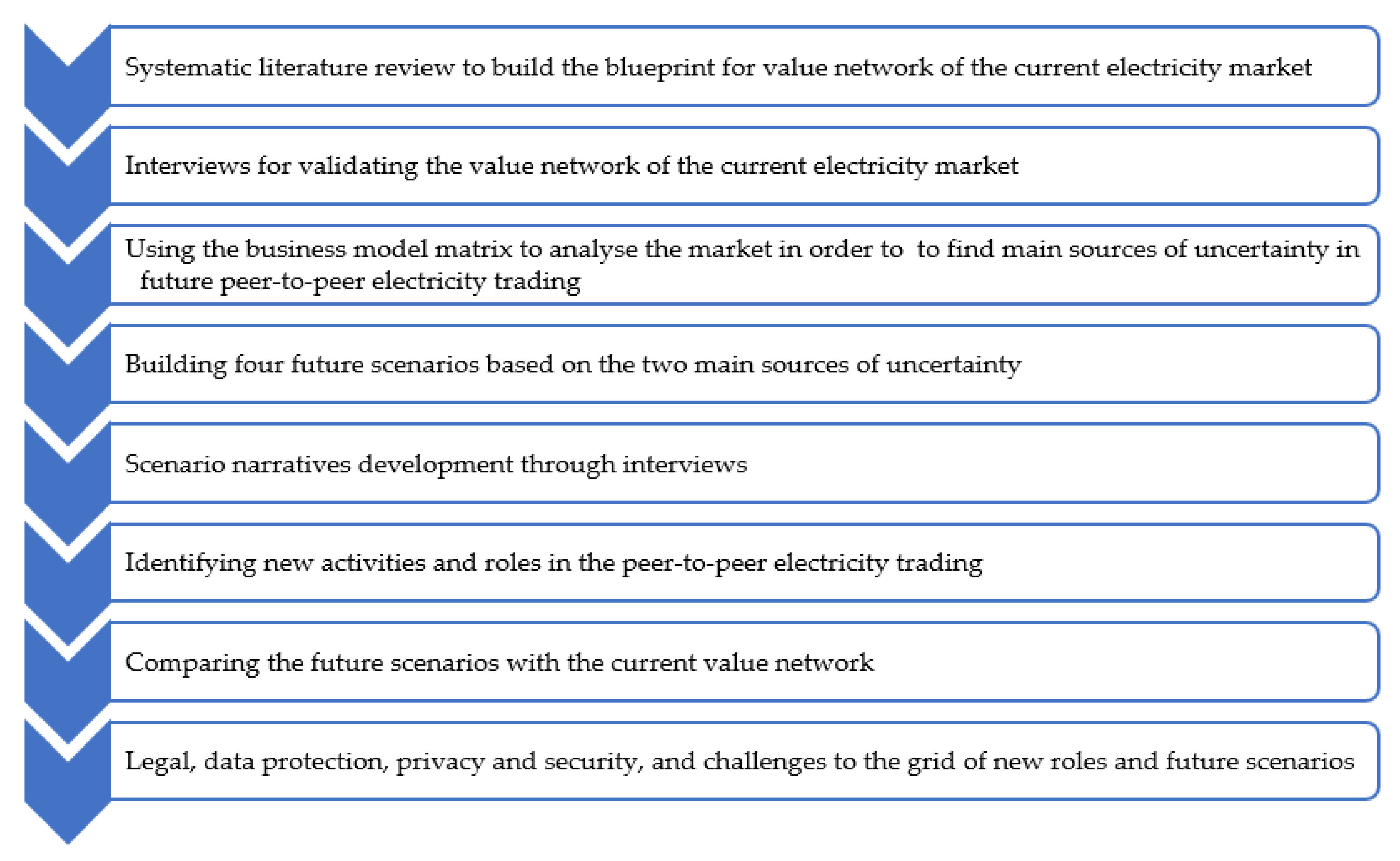
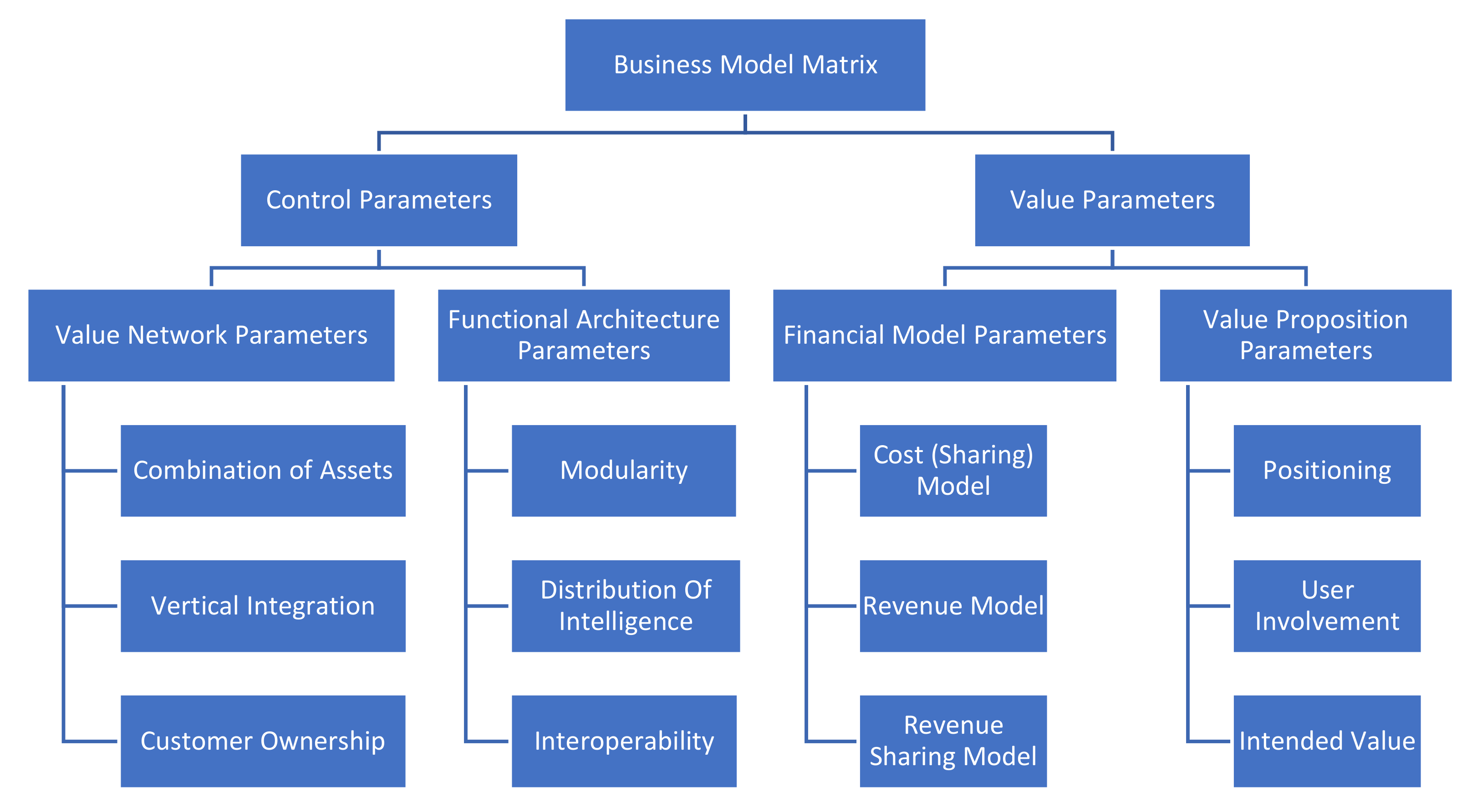
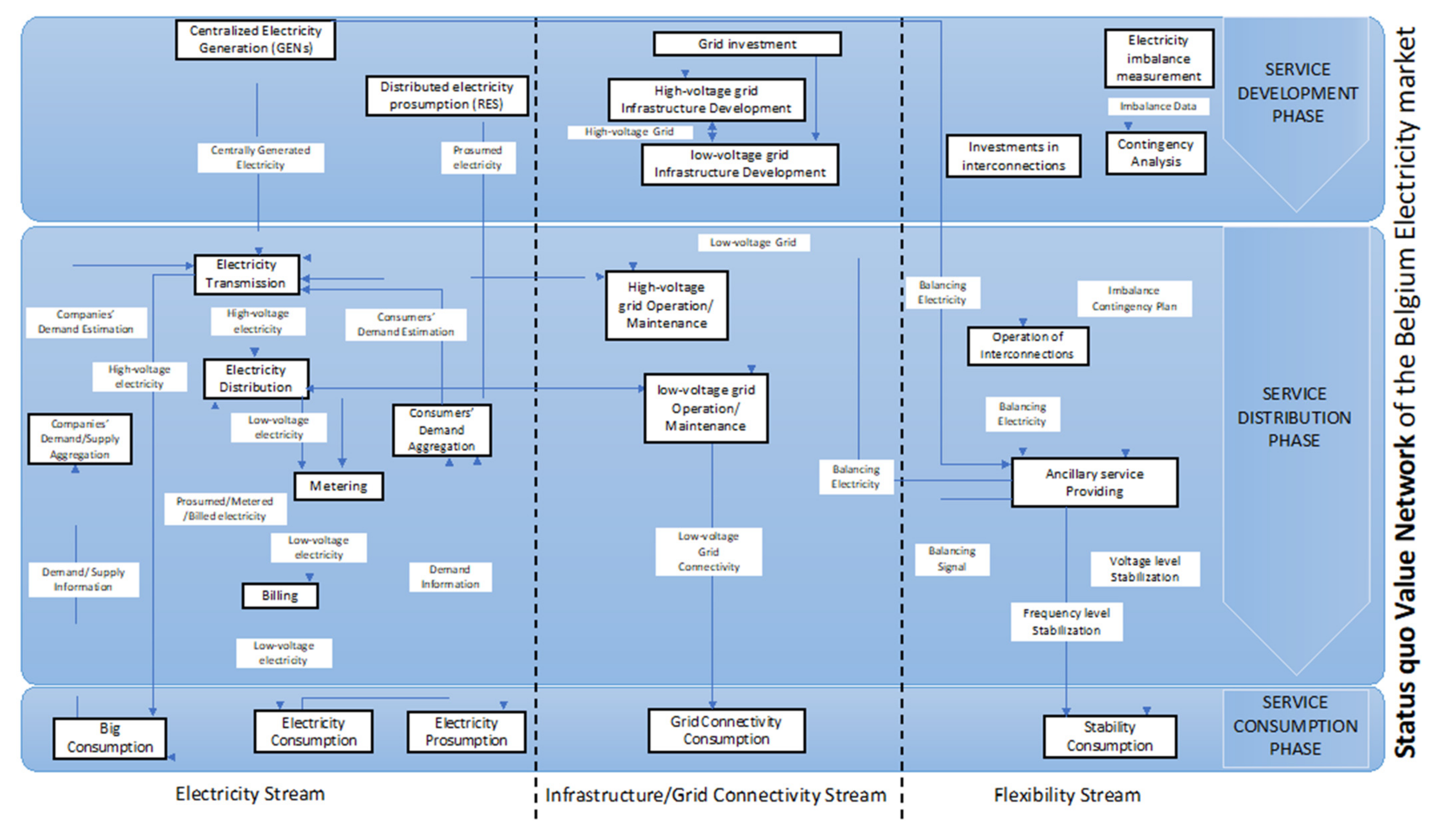
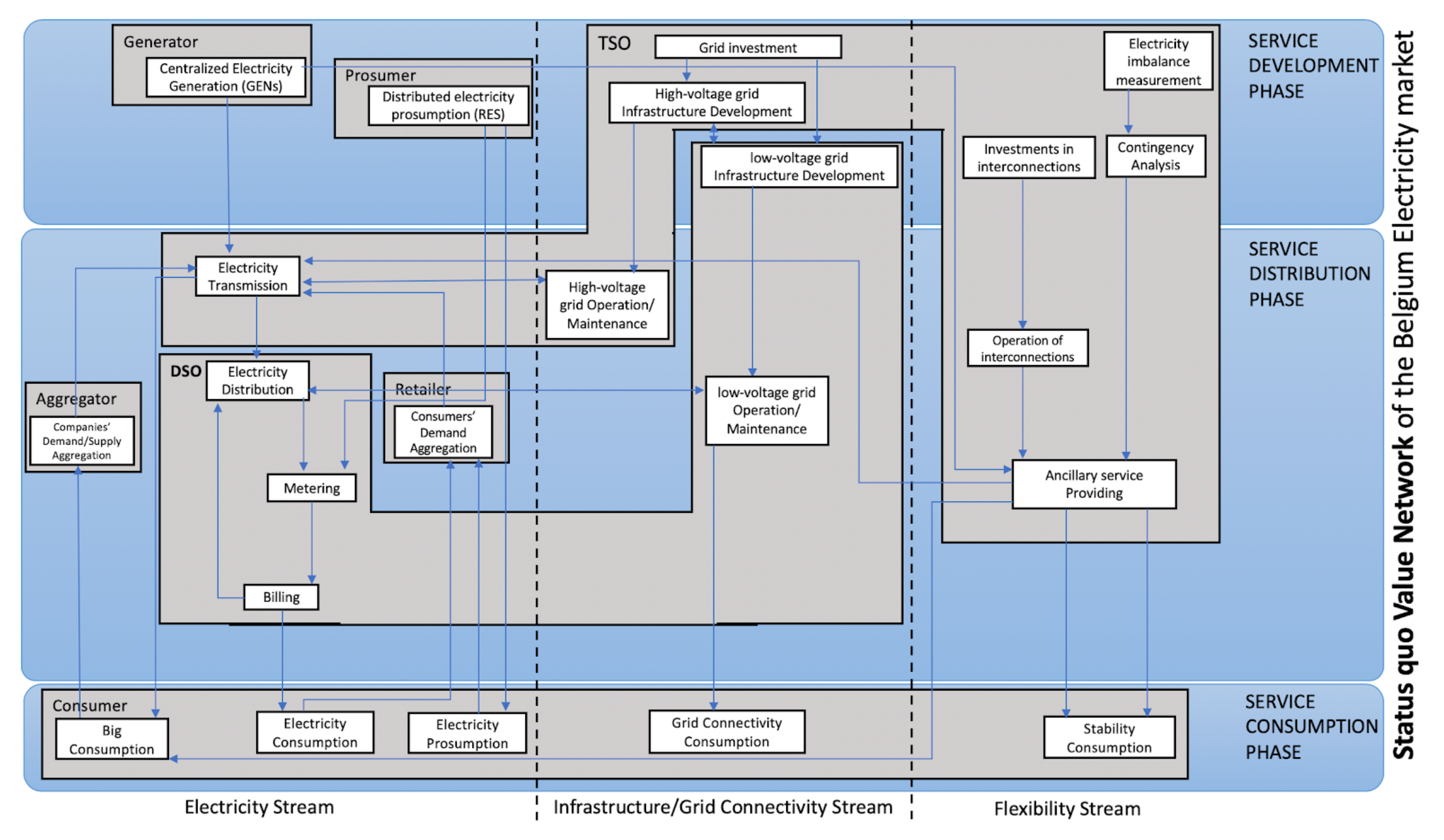
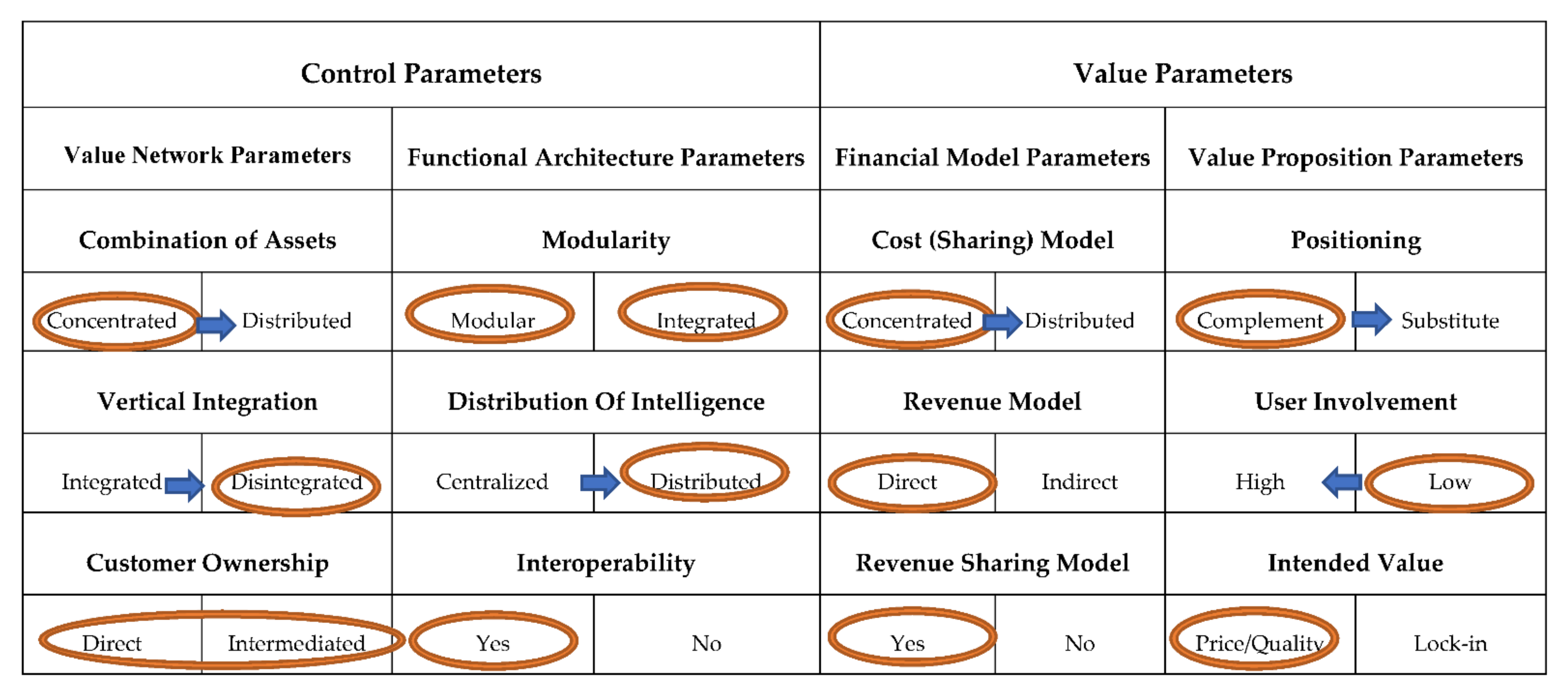
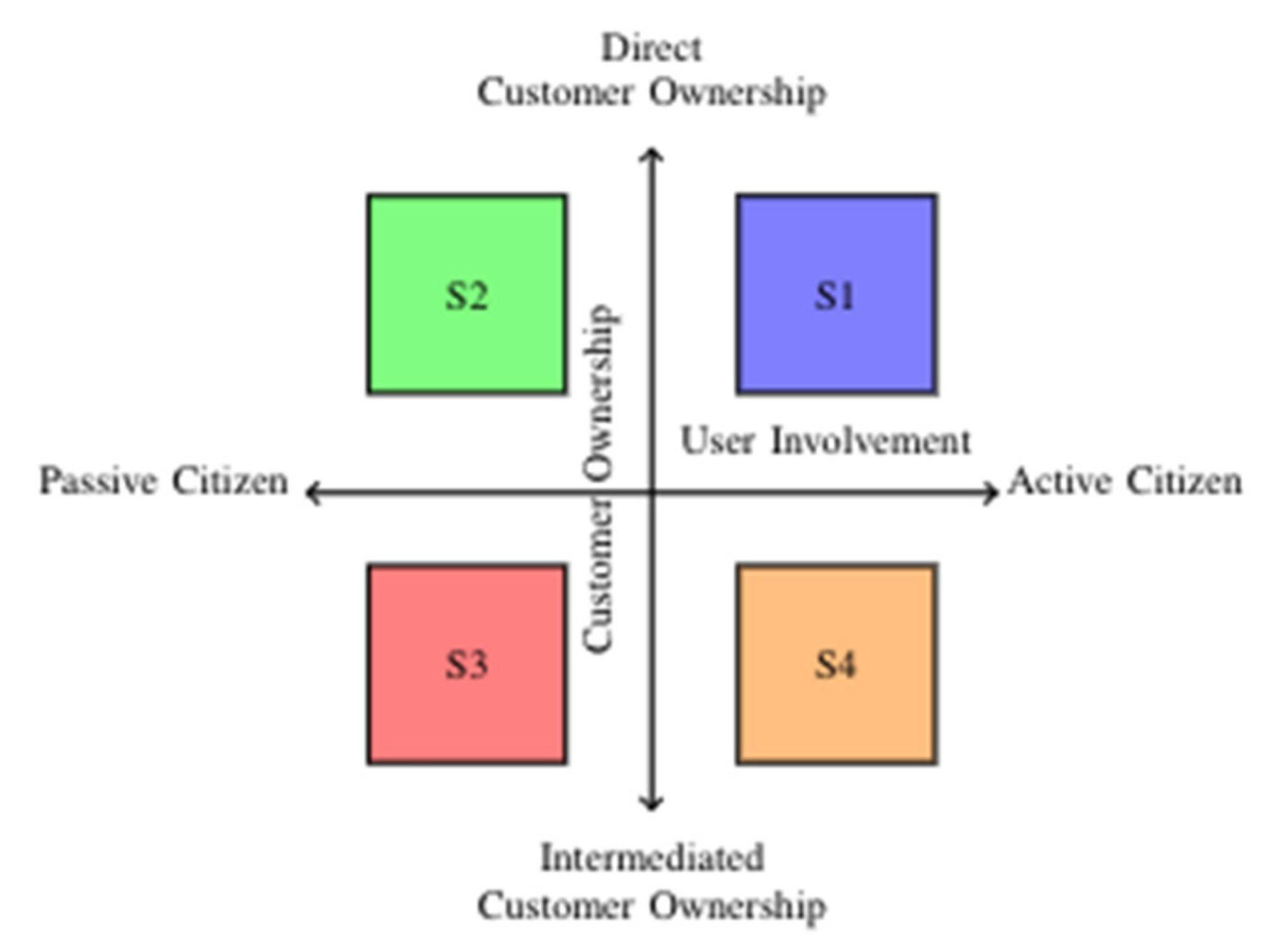

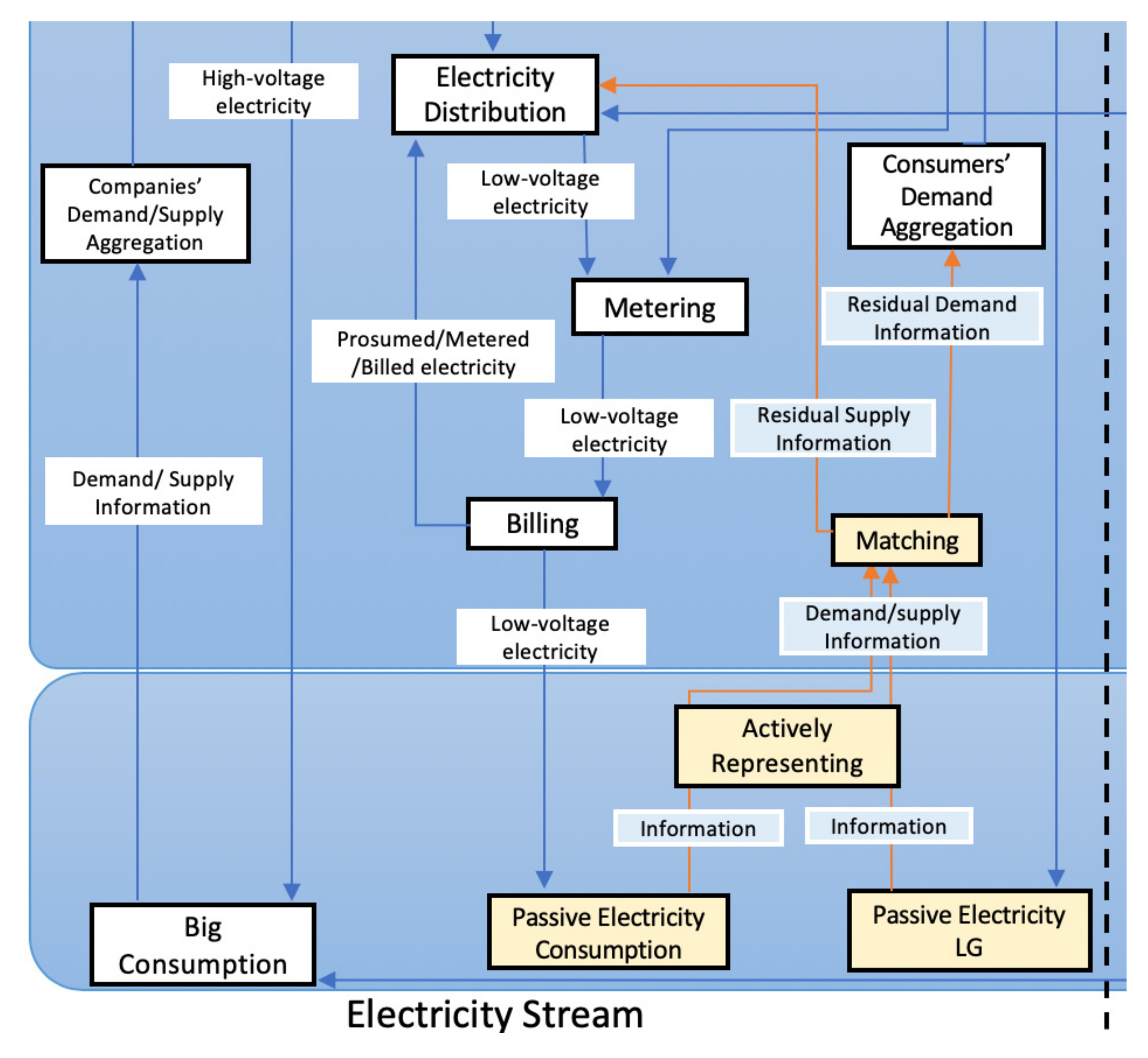
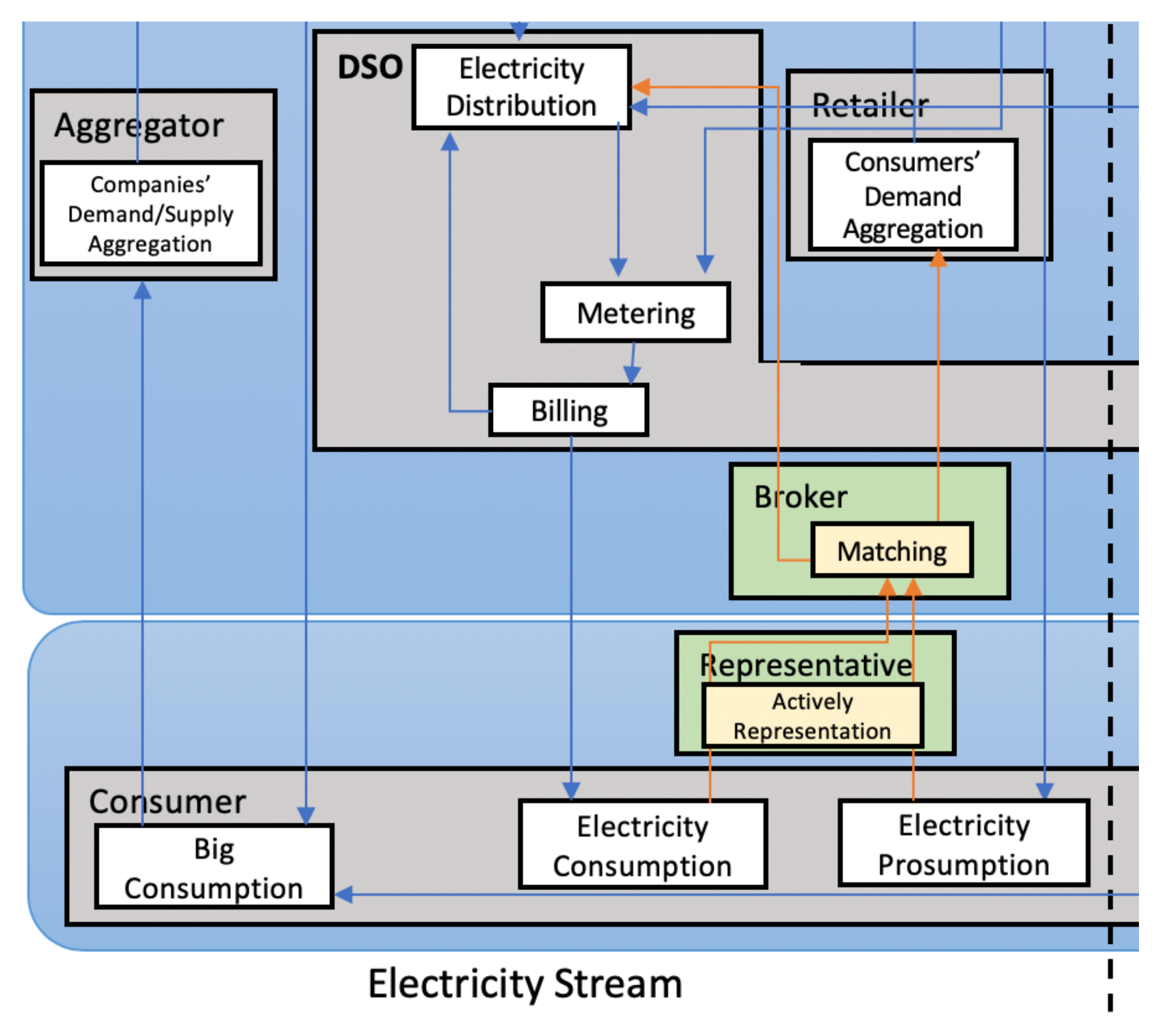
Publisher’s Note: MDPI stays neutral with regard to jurisdictional claims in published maps and institutional affiliations. |
© 2021 by the authors. Licensee MDPI, Basel, Switzerland. This article is an open access article distributed under the terms and conditions of the Creative Commons Attribution (CC BY) license (https://creativecommons.org/licenses/by/4.0/).
Share and Cite
Montakhabi, M.; Zobiri, F.; van der Graaf, S.; Deconinck, G.; Orlando, D.; Ballon, P.; Mustafa, M.A. An Ecosystem View of Peer-to-Peer Electricity Trading: Scenario Building by Business Model Matrix to Identify New Roles. Energies 2021, 14, 4438. https://doi.org/10.3390/en14154438
Montakhabi M, Zobiri F, van der Graaf S, Deconinck G, Orlando D, Ballon P, Mustafa MA. An Ecosystem View of Peer-to-Peer Electricity Trading: Scenario Building by Business Model Matrix to Identify New Roles. Energies. 2021; 14(15):4438. https://doi.org/10.3390/en14154438
Chicago/Turabian StyleMontakhabi, Mehdi, Fairouz Zobiri, Shenja van der Graaf, Geert Deconinck, Domenico Orlando, Pieter Ballon, and Mustafa A. Mustafa. 2021. "An Ecosystem View of Peer-to-Peer Electricity Trading: Scenario Building by Business Model Matrix to Identify New Roles" Energies 14, no. 15: 4438. https://doi.org/10.3390/en14154438
APA StyleMontakhabi, M., Zobiri, F., van der Graaf, S., Deconinck, G., Orlando, D., Ballon, P., & Mustafa, M. A. (2021). An Ecosystem View of Peer-to-Peer Electricity Trading: Scenario Building by Business Model Matrix to Identify New Roles. Energies, 14(15), 4438. https://doi.org/10.3390/en14154438









